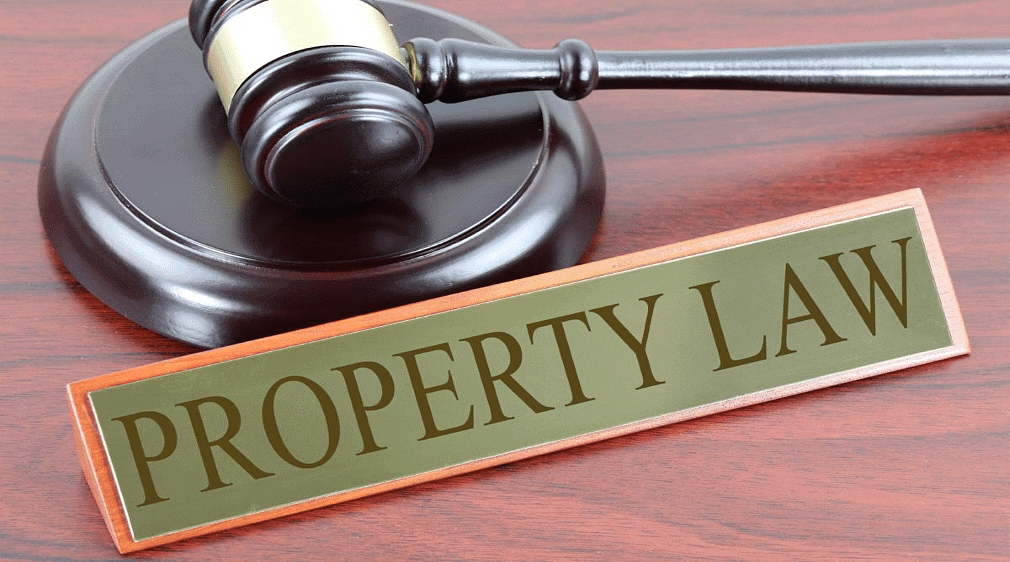Law of Property Chapter Notes | Revision Notes for CUET Commerce Preparation PDF Download
Introduction
Matters relating to property are governed by the Transfer of Property Act, 1882 in India.
 The object of the Transfer of Property Act (called the TPA under the unit of Property Law) is to regulate the transfer of property between living persons.
The object of the Transfer of Property Act (called the TPA under the unit of Property Law) is to regulate the transfer of property between living persons.
Types of Property
Every interest or right that has an economic value denotes property.
Property is of two kinds - movable and immovable.
- Movable property is one which can be transferred from one place to another and is governed by the Sale of Goods Act.
- Any property that is attached to the earth and cannot be transferred from one place to another is called immovable property.
Transfer
Who can transfer property?
Any person who is competent to contract (person above 18 years of age, having sound mind and not disqualified by any law in force) and authorized to dispose off property viz., owner of the property or any person authorized to sell the property, can make a transfer.
The person who Transfers the property is called the Transferor and the person to whom the transfer is made is called the Transferee.
 How can property be transferred?
How can property be transferred?
The mode of transfer of property varies according to the value of the property.
- If the value of the property is more than 100/-, then transfer has to be made only by a registered instrument.
- If the property is tangible and the value of the property is less than 100/-, irrespective of the value of the property, then transfer has to be made only by delivery.
- Whereas for intangible property, irrespective of the value of the property, transfer has to be made only by registered instrument.
A registered instrument has to be attested at least by two persons who are parties to the transfer. Attestation means affixing the signature in the registered instrument. The witnesses should mark their signature too on the instrument with an intention to attest. Registration shall take place by affixing a seal of the Registrar office which shall be subsequently included in the official records.
Essentials for a Valid Transfer
- In a transfer of property, the transfer should be between two or more living persons.
- The property that is going to be transferred should be free from encumbrances (hindrances of any form) and be of a transferable nature.
- The transfer should not be:
i) for an unlawful object or an unlawful consideration (for a detailed understanding, refer the chapter on Contracts);
ii) involving a person legally disqualified to be a transferor or transferee. - The transferor who transfers the property must:
i) be competent to make the transfer;
ii) be entitled to the transferable property;
iii) be authorized to dispose off the property if the property is not his own property.
iv) The transfer should be made according to the appropriate mode of transfer.
v) Necessary formalities like registration, attestation, etc. should be complied with. - In the case of a conditional transfer, where an interest is created on the fulfillment of a condition, the condition should not be illegal, immoral, impossible or opposed to public policy.
Doctrine of Election
- According to the principle of Doctrine of Election ‘Section 35 of the TPA’, a party to the transfer cannot accept as well as reject in a single transaction.
- If a person to the transfer gets two selections (a benefit and a burden), then he has to accept both the benefit and the burden or none.
- He cannot accept the benefit and reject the burden in a single transaction.
Example: A sells his garden as well as his house through one instrument to B. whereas, B wants to retain only the house and wants to cancel the transfer regarding the garden. According to the doctrine of Election, B has to retain the garden if he wants to retain the house, or cancel the whole transaction. B cannot retain the house and cancel the transfer regarding the garden.
Doctrine of Lis Pendens
- The Doctrine of Lis Pendens emerged from the Latin maxim 'ut lite pendent nihil innoveteur' meaning 'nothing new should be introduced in a pending litigation'.
- To constitute lis pendens, the following conditions should be satisfied:
i) A suit or proceeding involving the immovable property should be pending;
ii) The right to the immovable property must be in question in the suit or proceeding;
iii) The property in litigation should be transferred;
iv) The transferred property should affect the rights of the other person to the transfer.
Example: A has a litigation in determining the title of the property with ;. 'during the period of litigation, A initiates a sale of the property in favour of B. According to the doctrine of lis Pendens, the property cannot be sold because the property is involved in litigation.
Sale
- Sale means a transfer of ownership (right to possess something) of the property in exchange for a price (money) ‘Section 54 of the TPA’.
- Seller is the person who transfers the property and buyer is the person to whom the property is transferred.

Example: A sells his house for Rs. lakhs to B. This is called sale, where, A is the seller and B is the buyer. Rs. lakhs is the consideration which is money.
The following are the essentials for a sale to be valid:
- There should be two different parties- the seller and the buyer;
- Both the parties should be competent to transfer;
- The property to be transferred should be in existence;
- Consideration for the transfer should be money;
- The contract should be in accordance with law.
Liabilities of Seller:
- Disclose defects of the property which is known to the seller and is not known to the buyer;
- Produce to the buyer all documents of title (documents regarding ownership) relating to the property;
- Answer all the questions put to him by the buyer in relation to the property;
- Take care and preserve the property and the documents of title between the date of the contract of sale and the delivery of the property;
- Bear all public charges and rent with regard to the property up to the date of sale;
- To give the buyer possession of the property.
Rights of Seller:
- Collect the rents and profits of the property till the ownership passes to the buyer;
- When ownership has passed on to the buyer from the seller before payment of money in full, claim the amount from the buyer that is due to him.
Liabilities of Buyer:
- Disclose to the seller any fact with regard to the property that will increase the value of the property that is known to him;
- Pay to the seller purchase money at the time of completing the sale;
- To bear any loss that arises from the destruction, injury or decrease in value of the property after the ownership has passed to the buyer;
- To pay all public charges and rent that becomes payable after the ownership passed to the buyer.
Rights of Buyer:
- After the ownership has passed to the buyer, perform any lawful action to increase the value of property and the rents and profits with regard to the property;
- Where the buyer has paid the purchase money, he can compel the seller for registration of sale.
Lease
Lessor is the person who lets out the property for lease or transferor, and lessee is the person to whom the property is leased or the transferee in a lease.

Lease is a transfer of right to enjoy a property for a specific period of time in consideration for a price.
Example: A for a period of years lets out his property for use to B for a sum of Rs. 5, This is called lease. A is the lessor and B is the lessee. If B sublets the property to C, then B will be the lessee and C will be the sublessee. The relation between B and C will be of that relation that is between A and B.
Rights and Liabilities of the Lessor:
- Disclose defects of the property which is known to him and is not known to the lessee;
- Give possession of the property to the lessee;
- The lessor shall let out the property for lease to the lessee and make sure the lessee enjoys the property without any interruption upon payment of money.
Rights and Liabilities of the Lessee
- If any addition is made to the lease property during the lease period, then the addition can be comprised in the lease;
- If any part of the lease property is destroyed or made unfit by flood, fire, etc., then the lease shall be voidable by the lessee (the lessee gets a right to accept or reject depending on his wish);
- If the lessor fails to make repairs to the leased property, the lessee may make the repairs himself and recover the amount for the repairs from the lessor;
- If the lessor fails to make any payment with respect to the property and is recovered from the lessee, the lessee shall get it reimbursed from the lessor;
- At the time of completion of the lease, the lessee should hand over the property to the lessor in the state in which it was received;
- The lessee may transfer, rent or sub-let the leased property with the consent of the lessor;
- Disclose to the lessor any fact that lies in the property that will increase the value of the property;
- The lessee should pay rent at a proper time and place as specified by the lessor;
- The lessee is bound to keep the leased property in good condition when he is in possession of the property.
- When notice of any defect is given to the lessee, he is bound to rectify it within a period of three months;
- The lessee may use the property and its products and must not do anything that is destructive to the property;
- The lessee should not erect any permanent structure in the property without the consent of the lessor;
- The lessee is bound to put the lessor in possession of the property for determination of lease.
Exchange
When two persons transfer ownership of one thing for the ownership of another, it is called exchange ‘Section 118 of the TPA’.
Example: A offers to sell his cottage to B. B in consideration of the cottage sells his farm to A. Instead of getting money for his cottage, A has received a farm from B. This is an example for exchange. The rights and liabilities of A will be that of seller towards the sale of the cottage and will be that of buyer towards the sale of the farm. Similarly, the rights and liabilities of B will be that of buyer towards the sale of the cottage and that of seller towards the sale of the farm.
Gift
A transfer of ownership of property that is made voluntarily and without consideration is called Gift ‘Section 122 of the TPA’. 
The person making the transfer is called the donor and the person to whom it is made is called the donee.
If the donee expires before accepting the gift, it becomes void.
Example: A gives his car to B. B accepts the car. But B does not pay anything in return for the car. This is known as gift. In this case, A is the donor and B is the donee.
[Intext Question]
Difference between Sale, Lease, Exchange and Gift

Intellectual Property
Any work such as invention, artistic work or literary work, design, symbol, name, image, etc. created by the knowledge or intellectual capacity of a person is called intellectual property. Such intellectual property can be protected by law.

- Trademarks: Any mark put on the product such as the name of a product or service (Brand name ) which helps people to distinguish it from other products and services is called a Trademark. The names of a products, companies, etc. are Trademarks. (Example: Apollo Pharmacy, Titan watches, etc.)
- Patents: The right granted over the invention of a product is called Patent. In other words, when a person makes a new product, he can get a patent for the product.
- Copyrights: Copyright is the right obtained over the creation of any literary or artistic work. Books, music, films, paintings, scriptures, etc. are covered under copyright
- Designs: Any design invented by a person shall be protected by Designs. Shape, colour, line, pattern, etc. are covered under Designs
- Geographical Indications: Certain products or goods have a specific geographical origin and possess characteristics that attribute to the place of origin. Such goods and products bear the name of the geographical origin. This is called geographical indication. (Example: Darjeeling tea, Tirupathi laddu, etc.)
FAQs on Law of Property Chapter Notes - Revision Notes for CUET Commerce Preparation
| 1. What are the different types of property discussed in the Law of Property chapter? |  |
| 2. What are the essentials for a valid transfer of property according to the chapter? |  |
| 3. What is the Doctrine of Lis Pendens and how does it relate to property law? |  |
| 4. How does the Doctrine of Election apply in property law? |  |
| 5. What are the key differences between a sale and a lease of property as discussed in the Law of Property chapter? |  |

















